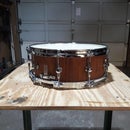Introduction: Fat Bike Bar Covers
This instructable is likely for a relatively small audience. The Bar Covers are intended to cover the handlebar area of a bicycle, in this case a fat bike used to ride in the snow and cold of winter. These covers provide an additional windbreak and insulation against the windchill of your hands on the handlebars. I have survived for 3 winters riding without this device, but at times my fingers have become cold, yes, even bitter cold. And that is while wearing specific gloves with a "lobster" style finger design that are intended to allow one to operate the brakes and shifters on a fat bike and still stay warm. However, this winter has been the coup de gras for cold hands. So today, while shopping in a local thrift store, I came up with this take on an already marketed idea but under my own moniker:
Fat Bike Bar Covers
Step 1: The Tools You Will Need
The tools for this project are few. A sewing machine (does not have to be a vintage Made in Sweden by Husqvarna Viking automatic, but it helps) a pair of scissors, and a talented seamstress (my wife).
Step 2: Raw Materials and Making the Cuts
The next thing you will need is the raw material to construct the Bar Cover. While in the thrift store I looked at ski pants, a long women's coat, a kid's parka, and then finally settled on this bomber style insulated nylon jacket. The jacket was black on the outside, but I was looking for dual purpose and chose the eye-catching orange liner for my outside color. The first step is to cut the sleeve off at the shoulder seam. We cut ours just above the seam. Next we cut the ribbed cuff off after finding that it was too snug of a fit going over the brake levers. I then determined the length that I needed and cut off the remaining piece closest to the end of the sleeve (that I would be discarding). The third picture shows the two layers of nylon and the poly fill insulating material that made up the jacket.
Step 3: Finishing the Cover
After the length was determined and the final cuts made, we sewed the hem on both ends of the Bar Cover. As you can see from the second picture, the Bar Cover has a flare on the end that followed the shoulder seam. This end will be to the outside of the handlebar to allow for easy entry and exit for my gloved hand.
Step 4: Mounting the Bar Covers
The Bar Covers slide right on over the brake levers, handlebar grips and protruding cables operating the brakes and shifters. As pictured in the second picture above, you can see that the covers bunch up at the junction of the stem and handlebar. The length of your covers will depend somewhat on this distance, the size of your hands, and style of the handlebar. I "dry fit" or measured this before I even took scissors to jacket to be sure where I wanted to make the cuts. I would say make them slightly longer than you think you should, you can always cut again if needed.
Step 5: Warm Hands...even at 3 Degrees F and -20 Windchill...
My hands have never been warmer on the fat bike! I look forward to seeing yours!
This is one Bar Cover charge that you won't mind paying: $8 for my used jacket at the thrift store. Retail prices of similar products that are manufactured run anywhere from $65 - $120.
Enjoy!

Participated in the
Snow Contest











